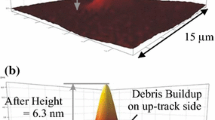Abstract
The corrosion of magnetic media has progressively became detrimental for computer hard-disk drive operation due to thinner protective overcoat (∼10 nm) and lower flying height of the magnetic head (∼20 nm), as required by high recording density. The corrosion product of cobalt oxide on the disk surface as migrated from cobalt alloy under the overcoat was evaluated using various techniques. The techniques applied were Time of Flight Secondary Ion Mass Spectroscopy (TOF-SIMS), Ion Chromatography (IC) and Inductively Coupled Plasma-Optical Emission Spectroscopy (ICP-OES). Electrochemical method and X-ray Photo-emission spectroscopy were found to have insufficient sensitivity for the corrosion level investigated. TOF-SIMS was found to be the most sensitive and repeatable technique among all the techniques. The cobalt amount was found to increase with decreasing overcoat thickness and with increasing exposure time to high humidity (80%) and high temperature (60°C), as encountered in disk drive storage conditions. The time dependence of cobalt amount on exposure time suggests a diffusion mechanism for cobalt migration to the disk surface. Some of those techniques can be applied to measure other corrosion products and/or to other fields for corrosion studies as well.
Similar content being viewed by others
Author information
Authors and Affiliations
Additional information
Received: 24 November 1997 / Accepted: 13 December 1997
Rights and permissions
About this article
Cite this article
Gao, C. Corrosion evaluation of cobalt based magnetic films using various techniques. Mat Res Innovat 1, 238–242 (1998). https://doi.org/10.1007/s100190050048
Published:
Issue Date:
DOI: https://doi.org/10.1007/s100190050048




